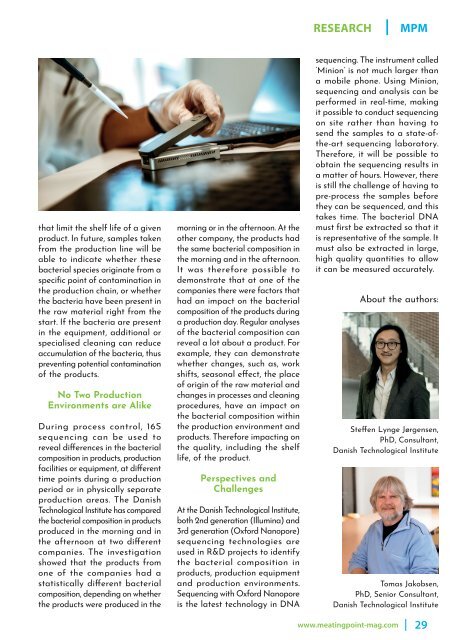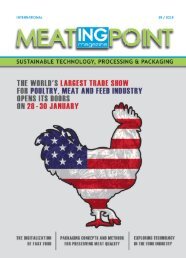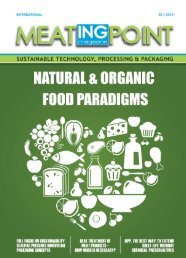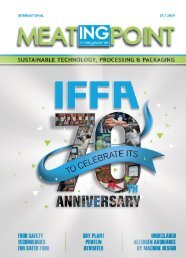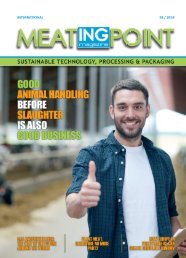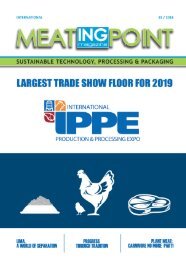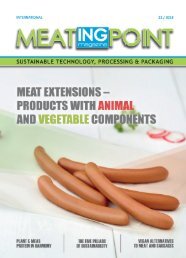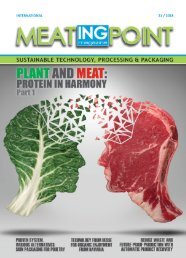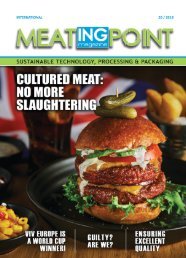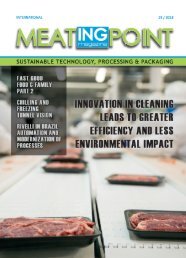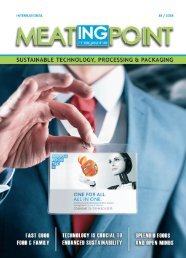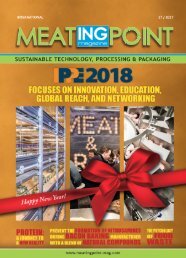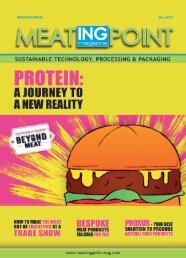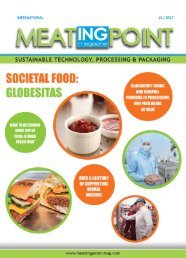MEATing POINT Magazine: #27 / 2019
Create successful ePaper yourself
Turn your PDF publications into a flip-book with our unique Google optimized e-Paper software.
RESEARCH<br />
| MPM<br />
that limit the shelf life of a given<br />
product. In future, samples taken<br />
from the production line will be<br />
able to indicate whether these<br />
bacterial species originate from a<br />
specific point of contamination in<br />
the production chain, or whether<br />
the bacteria have been present in<br />
the raw material right from the<br />
start. If the bacteria are present<br />
in the equipment, additional or<br />
specialised cleaning can reduce<br />
accumulation of the bacteria, thus<br />
preventing potential contamination<br />
of the products.<br />
No Two Production<br />
Environments are Alike<br />
During process control, 16S<br />
sequencing can be used to<br />
reveal differences in the bacterial<br />
composition in products, production<br />
facilities or equipment, at different<br />
time points during a production<br />
period or in physically separate<br />
production areas. The Danish<br />
Technological Institute has compared<br />
the bacterial composition in products<br />
produced in the morning and in<br />
the afternoon at two different<br />
companies. The investigation<br />
showed that the products from<br />
one of the companies had a<br />
statistically different bacterial<br />
composition, depending on whether<br />
the products were produced in the<br />
morning or in the afternoon. At the<br />
other company, the products had<br />
the same bacterial composition in<br />
the morning and in the afternoon.<br />
It was therefore possible to<br />
demonstrate that at one of the<br />
companies there were factors that<br />
had an impact on the bacterial<br />
composition of the products during<br />
a production day. Regular analyses<br />
of the bacterial composition can<br />
reveal a lot about a product. For<br />
example, they can demonstrate<br />
whether changes, such as, work<br />
shifts, seasonal effect, the place<br />
of origin of the raw material and<br />
changes in processes and cleaning<br />
procedures, have an impact on<br />
the bacterial composition within<br />
the production environment and<br />
products. Therefore impacting on<br />
the quality, including the shelf<br />
life, of the product.<br />
Perspectives and<br />
Challenges<br />
At the Danish Technological Institute,<br />
both 2nd generation (Illumina) and<br />
3rd generation (Oxford Nanopore)<br />
sequencing technologies are<br />
used in R&D projects to identify<br />
the bacterial composition in<br />
products, production equipment<br />
and production environments.<br />
Sequencing with Oxford Nanopore<br />
is the latest technology in DNA<br />
sequencing. The instrument called<br />
‘Minion’ is not much larger than<br />
a mobile phone. Using Minion,<br />
sequencing and analysis can be<br />
performed in real-time, making<br />
it possible to conduct sequencing<br />
on site rather than having to<br />
send the samples to a state-ofthe-art<br />
sequencing laboratory.<br />
Therefore, it will be possible to<br />
obtain the sequencing results in<br />
a matter of hours. However, there<br />
is still the challenge of having to<br />
pre-process the samples before<br />
they can be sequenced, and this<br />
takes time. The bacterial DNA<br />
must first be extracted so that it<br />
is representative of the sample. It<br />
must also be extracted in large,<br />
high quality quantities to allow<br />
it can be measured accurately.<br />
About the authors:<br />
Steffen Lynge Jørgensen,<br />
PhD, Consultant,<br />
Danish Technological Institute<br />
Tomas Jakobsen,<br />
PhD, Senior Consultant,<br />
Danish Technological Institute<br />
www.meatingpoint-mag.com | 29


